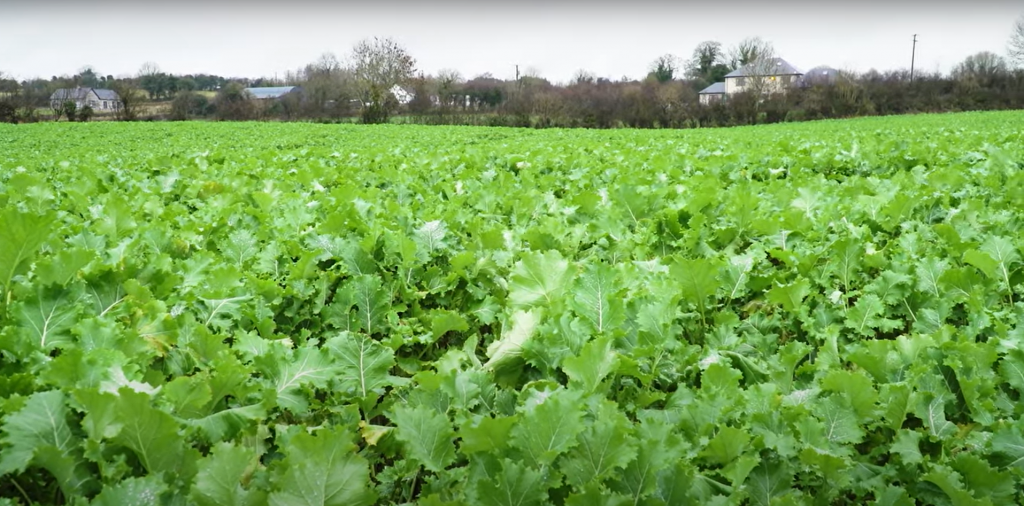With plenty of rainfall experienced in recent weeks, it can be hard to imagine out-wintering cattle on many farms.
Following a recent interview with Teagasc Green Acres Calf to Beef Programme participant Irvine Allen – AgriLand decided to take another trip out to his Westmeath-based farm.
We reviewed his management of out-wintering weanlings and aimed to see how ground conditions are coping during the damp conditions.
This year, Irvine reared 109 spring-born Holstein Friesian bull calves on his farm in Moate.
High-energy forage crop
Housing was completed back in November with the exception of 75 of the heaviest spring-born calves, which are currently grazing Redstart – a hybrid of forage rape and kale.
The weanlings will remain on this crop for the winter, before being turned onto grass in late February 2021.
Irvine has been growing this crop for the past four years. He has been utilising the benefits of out-wintering young stock on this forage crop – as it aids both rapid growth ability and all-year-round performance.
Grazing management
Some 75 weanlings were split up into three groups and are currently grazing the forage crop.
Each group of calves have been provided with a sheltered 1.5ac grass lie-back, which protects the calves from harsh weather conditions during the winter months.
For the moment, ground conditions are holding up very well, as Irvine states:
We would be very lucky here, the land would have very sandy and free-draining soil. Even if the ground gets mucky or wet, two days of drying and the ground will be in perfect condition again.
At the beginning of the grazing, Irvine had to be strategic in his management of these young animals on the Redstart crop. If he allowed these weanlings to graze into the forage crop straight away, it may result in some digestive upsets.
Therefore, a gradual introduction was commenced over the space of a few weeks to avoid this issue. He explains:
I would restrict the amount of crop that they are eating for the first two to three weeks to allow them to adjust to the diet and keep plenty of high-quality silage in front of them.
In order to meet recommendations on providing sufficient balance to these weanlings’ diet, high-quality baled silage (73 dry matter digestibility (DMD)) is fed alongside the forage crop. These each account for 50% of the animal’s diet.
The baled silage is being fed at a dry matter content of 36%. Assuming each bale weighs 600kg, it can be estimated that there is approximately 216kg of dry matter in each bale provided.
These young animals will have a dry matter appetite which is 2% of its own bodyweight. Therefore, taking into account the average weight of each weanling is 248kg, there is a requirement of 5kg DM/day/animal.
A re-calculation of these animals’ dry matter requirements will have to be reviewed regularly as their liveweight increases.
Dosing and Vaccination
As this forage crop contains goitrogens, it can disrupt the production of thyroid hormones by interfering with iodine uptake in the thyroid gland and, in turn, lead to goiter.
To avoid this, all of the calves were supplied with a mineral dose which is high in iodine before they entered the forage crop. Irvine said:
The fact the animals are on clay for a lot of the time during the day, it is important that I have them covered with the 10-in-1 vaccination for clostridial diseases.
They will continue to receive this mineral dose every four-to-six weeks to avoid an imbalance of iodine and ensure they continue to thrive. A seaweed lick is also made available to each group.
Additionally, all calves were treated with an Ivermectin pour-on and provided with an IBR vaccination.
Target weights
As previously stated, the average weight of the calves being out-wintered is 248kg – this result was taken from housing weighing conducted on November 4. Irvine stated:
The target is to get the weanlings having 0.6/kg of an average daily liveweight gain on the crop. If we can achieve this, we are hopefully going to see these animals reaching close to 310kg by the end of February.
From the remainder of the 109 spring-born calves, 34 of the lighter weanlings were housed – they recorded an average weight of 205kg.
These animals are currently receiving 2kg of 14% crude protein concentrate – along with high-quality (76 DMD) baled silage.
The concentrate feeding to these calves is being front loaded until the early stages of the winter. From then on, they will be reduced to average 1kg/day over the course of the winter period.




